外研版高三英语教案.doc
- 格式:doc
- 大小:64.50 KB
- 文档页数:29
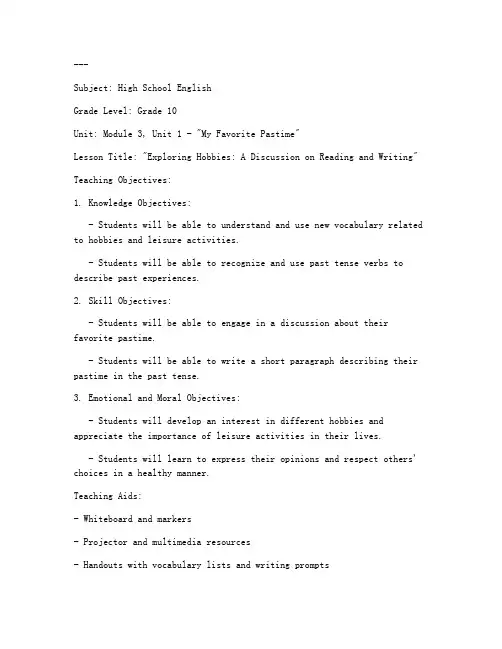
---Subject: High School EnglishGrade Level: Grade 10Unit: Module 3, Unit 1 - "My Favorite Pastime"Lesson Title: "Exploring Hobbies: A Discussion on Reading and Writing"Teaching Objectives:1. Knowledge Objectives:- Students will be able to understand and use new vocabulary related to hobbies and leisure activities.- Students will be able to recognize and use past tense verbs to describe past experiences.2. Skill Objectives:- Students will be able to engage in a discussion about their favorite pastime.- Students will be able to write a short paragraph describing their pastime in the past tense.3. Emotional and Moral Objectives:- Students will develop an interest in different hobbies and appreciate the importance of leisure activities in their lives.- Students will learn to express their opinions and respect others' choices in a healthy manner.Teaching Aids:- Whiteboard and markers- Projector and multimedia resources- Handouts with vocabulary lists and writing prompts- Cards for group discussionsTeaching Procedures:1. Warm-up (10 minutes)- Begin with a quick review of the previous unit to activate prior knowledge.- Ask students to share what they remember about hobbies and leisure activities.- Use a quick survey to gauge students' familiarity with different hobbies.2. Vocabulary Presentation (15 minutes)- Introduce new vocabulary related to hobbies using flashcards or a PowerPoint presentation.- Provide definitions and examples for each word.- Engage students in activities such as matching words with their definitions or using the words in sentences.3. Grammar Focus (10 minutes)- Explain the past tense and demonstrate how to form past tense verbs from regular and irregular verbs.- Provide examples and have students practice forming past tense sentences.- Use a fill-in-the-blanks activity to reinforce the grammar structure.4. Reading Activity (15 minutes)- Read a short passage about a person's favorite pastime, using a variety of reading strategies such as skimming and scanning.- Discuss the passage as a class, asking questions to check for understanding.- Analyze the structure of the passage and identify key information.5. Writing Activity (20 minutes)- Give students a writing prompt: "Describe a hobby you had when you were younger."- Have students write a short paragraph using the past tense.- Circulate around the classroom to provide feedback and support.6. Group Discussion (15 minutes)- Divide the class into small groups and give each group a card with a different hobby.- Have students discuss their hobby, using the new vocabulary and grammar they have learned.- Each group will then present their discussion to the class.7. Conclusion (5 minutes)- Summarize the key points of the lesson.- Ask students to reflect on what they have learned about hobbies and leisure activities.- Assign homework: Write a short essay about a hobby that they are interested in and why it is important to them.Assessment:- Observe student participation in class activities and discussions.- Evaluate the quality of students' writing and speaking.- Collect and review homework assignments.Evaluation Criteria:- Correct use of vocabulary and grammar.- Clarity and coherence of writing and speaking.- Engagement and participation in class activities.---This template provides a structured outline for a high school English lesson using materials from Yanran Press. The teacher can adapt the activities and resources to fit the specific needs and interests of their students.。
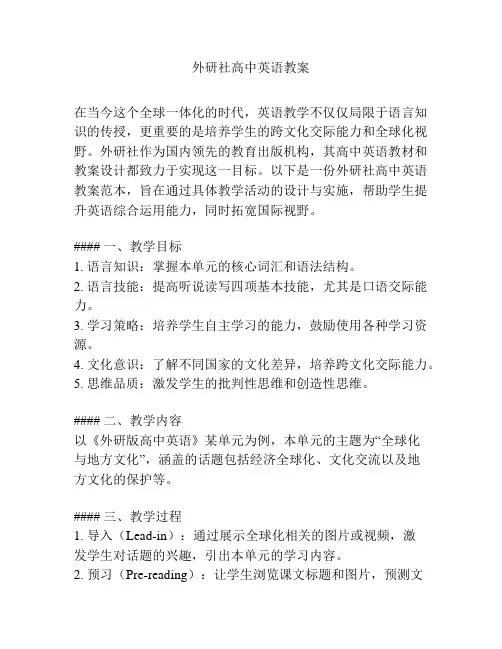
外研社高中英语教案在当今这个全球一体化的时代,英语教学不仅仅局限于语言知识的传授,更重要的是培养学生的跨文化交际能力和全球化视野。
外研社作为国内领先的教育出版机构,其高中英语教材和教案设计都致力于实现这一目标。
以下是一份外研社高中英语教案范本,旨在通过具体教学活动的设计与实施,帮助学生提升英语综合运用能力,同时拓宽国际视野。
#### 一、教学目标1. 语言知识:掌握本单元的核心词汇和语法结构。
2. 语言技能:提高听说读写四项基本技能,尤其是口语交际能力。
3. 学习策略:培养学生自主学习的能力,鼓励使用各种学习资源。
4. 文化意识:了解不同国家的文化差异,培养跨文化交际能力。
5. 思维品质:激发学生的批判性思维和创造性思维。
#### 二、教学内容以《外研版高中英语》某单元为例,本单元的主题为“全球化与地方文化”,涵盖的话题包括经济全球化、文化交流以及地方文化的保护等。
#### 三、教学过程1. 导入(Lead-in):通过展示全球化相关的图片或视频,激发学生对话题的兴趣,引出本单元的学习内容。
2. 预习(Pre-reading):让学生浏览课文标题和图片,预测文章大意,激活学生的背景知识。
3. 阅读(While-reading):分段阅读,每读完一段后进行问题讨论,检查学生对文本的理解程度。
4. 讲解(Post-reading):教师重点讲解文中的新词汇和重要语法点,引导学生归纳总结。
5. 练习(Practice):设计相关的听说读写练习,如角色扮演、辩论赛、写作练习等,巩固所学知识。
6. 应用(Application):组织学生进行小组合作,探讨如何平衡全球化与地方文化的关系,提出自己的见解。
7. 作业(Homework):布置相关的阅读和写作作业,要求学生在家中继续深化对话题的理解。
#### 四、教学方法1. 任务型教学:通过完成具体的任务来学习语言,如项目研究、情景模拟等。
2. 合作学习:鼓励学生小组合作,共同探讨问题,分享信息。

新外研版高中英语教案课程基本信息- 课程名称:高中英语(新外研版)- 适用年级:高中一年级至三年级- 教学目标:通过系统学习,使学生能够熟练运用英语进行听说读写,提高综合语言运用能力。
教案设计第一部分:导入(Warming u)- 目的:激发学生兴趣,为学习主题做铺垫。
- 方法:通过播放与课题相关的短视频或图片,让学生进入英语学习的状态。
第二部分:听力训练(Listening)- 目的:培养学生的英语听力理解能力。
- 方法:使用教材配套的听力材料,进行精听和泛听练习。
第三部分:口语实践(Seaking)- 目的:提高学生的英语口语表达能力。
- 方法:分组讨论、角色扮演、情景对话等互动形式。
第四部分:阅读理解(Reading)- 目的:加强学生的阅读技巧和理解能力。
- 方法:快速阅读抓取文章大意,细读理解文章细节,并进行问题讨论。
第五部分:写作技巧(Writing)- 目的:锻炼学生的英语写作能力。
- 方法:根据所学内容,指导学生撰写短文或作文。
第六部分:语言点讲解(Language oints)- 目的:帮助学生掌握重点词汇和语法结构。
- 方法:通过例句和练习题加深理解和记忆。
第七部分:复习与巩固(Review and consolidation)- 目的:巩固所学知识,提高长期记忆效果。
- 方法:小组竞赛、头脑风暴、小测试等形式。
教学反思每堂课后,教师需对教学过程进行反思,包括教学方法的有效性、学生的学习情况以及如何改进等方面。
这有助于不断提升教学质量,更好地满足学生的学习需求。
结语。
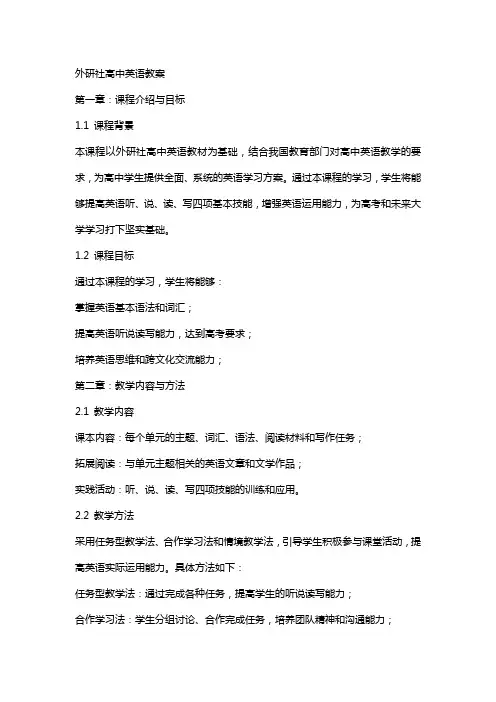
外研社高中英语教案第一章:课程介绍与目标1.1 课程背景本课程以外研社高中英语教材为基础,结合我国教育部门对高中英语教学的要求,为高中学生提供全面、系统的英语学习方案。
通过本课程的学习,学生将能够提高英语听、说、读、写四项基本技能,增强英语运用能力,为高考和未来大学学习打下坚实基础。
1.2 课程目标通过本课程的学习,学生将能够:掌握英语基本语法和词汇;提高英语听说读写能力,达到高考要求;培养英语思维和跨文化交流能力;第二章:教学内容与方法2.1 教学内容课本内容:每个单元的主题、词汇、语法、阅读材料和写作任务;拓展阅读:与单元主题相关的英语文章和文学作品;实践活动:听、说、读、写四项技能的训练和应用。
2.2 教学方法采用任务型教学法、合作学习法和情境教学法,引导学生积极参与课堂活动,提高英语实际运用能力。
具体方法如下:任务型教学法:通过完成各种任务,提高学生的听说读写能力;合作学习法:学生分组讨论、合作完成任务,培养团队精神和沟通能力;情境教学法:创设真实、有趣的英语情境,激发学生学习兴趣。
第三章:课堂活动设计3.1 热身活动每节课开始前,用5-10分钟时间进行热身活动,如唱英文歌曲、轻松对话等,让学生迅速进入英语学习状态;鼓励学生积极参与,提高他们的自信心和积极性。
3.2 主体活动根据单元主题和教学目标,设计听、说、读、写等方面的课堂活动;采用任务型教学法,引导学生通过完成任务,巩固所学知识;结合合作学习法,组织学生分组讨论、互动交流,提高他们的沟通能力。
布置作业:根据学生实际情况,布置适量、适当的作业,巩固所学知识。
第四章:教学评价与反馈4.1 课堂评价观察学生在课堂活动中的表现,记录他们的听说读写能力进步情况;鼓励学生自我评价和同伴评价,提高他们的自我认知和反思能力。
4.2 作业评价及时批改学生作业,给予具体、详细的评价和反馈;关注学生的学习困难,针对性地进行指导。
4.3 定期考试与评估组织定期考试,检验学生的英语水平;根据考试结果,调整教学策略,为学生提供更有针对性的指导。
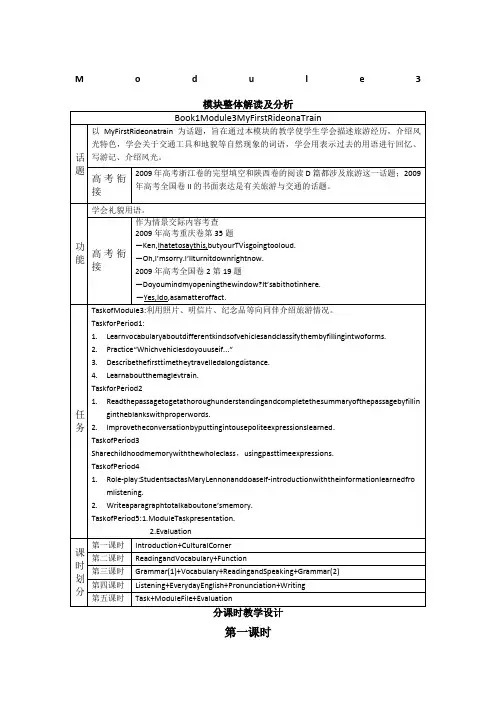
M o d u l e 3 —第一课时一、教学内容分析二、课堂教学过程第二课时一、教学内容分析二、课堂教学过程第三课时一、教学内容分析二、课堂教学过程第四课时一、教学内容分析二、课堂教学过程第五课时一、教学内容分析二、课堂教学过程附:模块基础知识检测题Module3MyFirstRideonaTrainI.单项选择1.WTOisshort_______theWorldTradeA.ofB.to.C.as.D.for2._________beautifulsceneryitiswheninspring!A.HowaB.WhataC.HowD.What3.Seeingthe__________thatthestudentswerebusypreparingtheirlessons,Icouldn’thelpanexpectingallof themtobeadmittedbycolleges.A.sceneryB.sightC.sceneD.view4.___________thecompanyatsuchaneveningparty,hehasbeenchoosingasuitwhichwill_____best.A.Representing;agreeB.Represented;fitC.Represent;matchD.Torepresent;suit5.Theperson______atthemeetingisfamous______anactor.A.referred;forB.referto;asC.referredto;forD.referring;as6.Theshort-wavecantravelthroughair_____light.A.ataspeedof B.atthespeedof C.inaspeedof D.inthespeedof7.Ifyouhavesometroublewithwork,Ican______youajobinthecompany.A.offerB.acceptC.supplyD.provide8.Hemadeanotherwonderfuldiscovery,_________ofgreatimportancetoscience.A.whichIthinkisB.whichIthinkitisC.whichIthinkitD.Ithinkwhichis9.Wearenotallowed_________intheclass.A.talkingB.totalkC.talkedD.read10.Inthelibrarywefoundhim________atadesk,withhisattention______onabook..A.sitting;fixingB.sit;fixedC.sitting;tobefixedD.seated;fixedII.翻译下列句子1.你认为那是什么舞蹈?2.我每天骑车去上学。
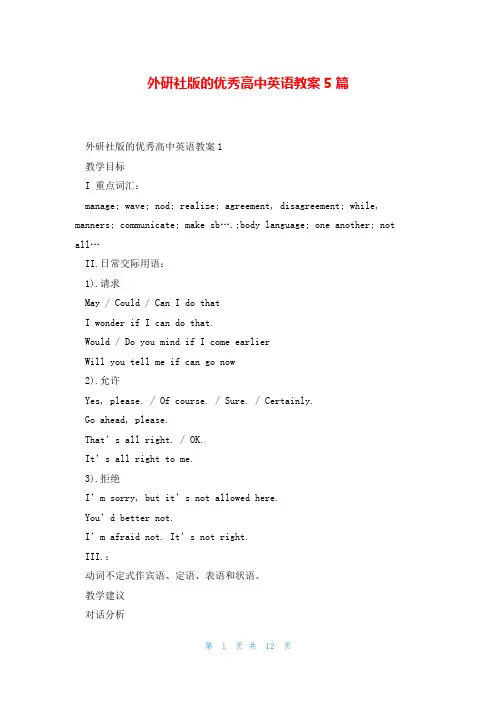
外研社版的优秀高中英语教案5篇外研社版的优秀高中英语教案1教学目标I 重点词汇:manage; wave; nod; realize; agreement, disagreement; while, manners; communicate; make sb….;body language; one another; not all…II.日常交际用语:1).请求May / Could / Can I do thatI wonder if I can do that.Would / Do you mind if I come earlierWill you tell me if can go now2).允许Yes, please. / Of course. / Sure. / Certainly.Go ahead, please.That’s all right. / OK.It’s all right to me.3).拒绝I’m sorry, but it’s not allowed here.You’d better not.I’m afraid not. It’s not right.III.:动词不定式作宾语、定语、表语和状语。
教学建议对话分析This lesson is to use offer help and how to accept and refuse help. While the Ss learn about the way of expression from the dialogue. Give some phrases to practise how to use and grasp better theability.课文分析This two materials about body language and train the Ss abilities of reading and speaking. Though reading the passages, the main idea is to have difference body languages of the countries. For example; welcome, agreement and disagreement, no, yes, happy, so on. Meanwhile the two passages offer the Ss the opportunity to talk about the body language of China , British and other counties.教学建议The teacher give the Ss the questions bout the dialogue firstly. For example: If you need some help , how do you offer them to help So on.The teacher help the Ss to listen in order to understand well,after that the Ss speak and talk each other according the content of the dialogue., So the teacher organize some students to play a role about offers, or divide a few groups to discuss. Finally the teacher summarize the useful expression of the dialogue.外研社版的优秀高中英语教案2教学目标知识目标:复习两个阅读技能---scanning, skimming;学习本单元的部分生词。
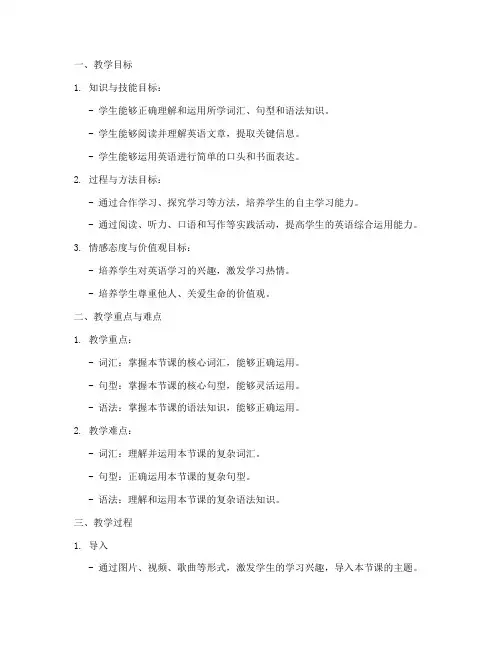
一、教学目标1. 知识与技能目标:- 学生能够正确理解和运用所学词汇、句型和语法知识。
- 学生能够阅读并理解英语文章,提取关键信息。
- 学生能够运用英语进行简单的口头和书面表达。
2. 过程与方法目标:- 通过合作学习、探究学习等方法,培养学生的自主学习能力。
- 通过阅读、听力、口语和写作等实践活动,提高学生的英语综合运用能力。
3. 情感态度与价值观目标:- 培养学生对英语学习的兴趣,激发学习热情。
- 培养学生尊重他人、关爱生命的价值观。
二、教学重点与难点1. 教学重点:- 词汇:掌握本节课的核心词汇,能够正确运用。
- 句型:掌握本节课的核心句型,能够灵活运用。
- 语法:掌握本节课的语法知识,能够正确运用。
2. 教学难点:- 词汇:理解并运用本节课的复杂词汇。
- 句型:正确运用本节课的复杂句型。
- 语法:理解和运用本节课的复杂语法知识。
三、教学过程1. 导入- 通过图片、视频、歌曲等形式,激发学生的学习兴趣,导入本节课的主题。
2. 新课导入- 通过复习旧知识,引入新知识,为新课做好铺垫。
3. 课堂讲解- 讲解本节课的词汇、句型和语法知识,结合实例进行讲解。
4. 课堂练习- 进行课堂练习,巩固所学知识,提高学生的运用能力。
5. 课堂活动- 组织课堂活动,如小组讨论、角色扮演等,让学生在活动中运用所学知识。
6. 总结- 对本节课所学知识进行总结,帮助学生梳理知识脉络。
7. 布置作业- 布置课后作业,巩固所学知识,提高学生的自主学习能力。
四、教学评价1. 课堂表现评价:- 关注学生的参与度、课堂纪律、合作意识等方面。
2. 作业评价:- 评价学生的作业完成情况,关注学生的进步和不足。
3. 期末评价:- 通过期末考试,全面评价学生的学习成果。
五、教学资源1. 教材:外研版高中英语教材。
2. 课件:制作与教学内容相关的课件,辅助教学。
3. 网络:利用网络资源,如英语学习网站、视频等,丰富教学内容。
4. 其他:实物教具、图片、歌曲等。
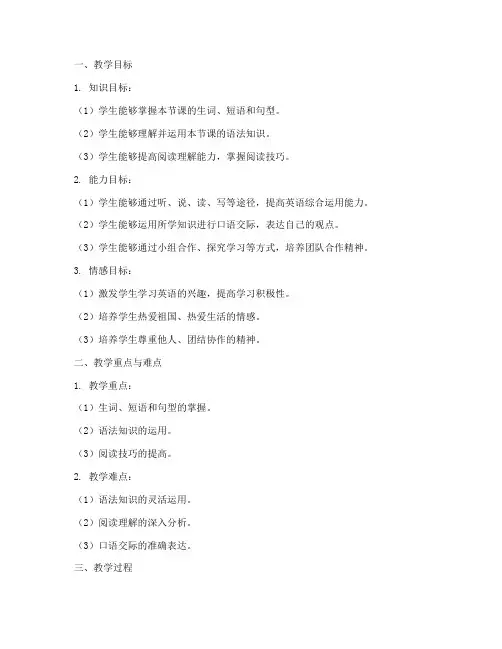
一、教学目标1. 知识目标:(1)学生能够掌握本节课的生词、短语和句型。
(2)学生能够理解并运用本节课的语法知识。
(3)学生能够提高阅读理解能力,掌握阅读技巧。
2. 能力目标:(1)学生能够通过听、说、读、写等途径,提高英语综合运用能力。
(2)学生能够运用所学知识进行口语交际,表达自己的观点。
(3)学生能够通过小组合作、探究学习等方式,培养团队合作精神。
3. 情感目标:(1)激发学生学习英语的兴趣,提高学习积极性。
(2)培养学生热爱祖国、热爱生活的情感。
(3)培养学生尊重他人、团结协作的精神。
二、教学重点与难点1. 教学重点:(1)生词、短语和句型的掌握。
(2)语法知识的运用。
(3)阅读技巧的提高。
2. 教学难点:(1)语法知识的灵活运用。
(2)阅读理解的深入分析。
(3)口语交际的准确表达。
三、教学过程1. 导入新课(1)通过图片、歌曲、视频等方式,激发学生学习兴趣,引入本节课的主题。
(2)引导学生回顾已学知识,为新课做好铺垫。
2. 新课导入(1)教师讲解本节课的生词、短语和句型,并进行示范。
(2)学生跟读、模仿,加深印象。
3. 语法讲解(1)教师详细讲解本节课的语法知识,并结合例句进行讲解。
(2)学生进行练习,巩固所学知识。
4. 阅读训练(1)教师布置阅读任务,学生自主阅读课文。
(2)教师引导学生分析课文,解答疑难问题。
(3)学生总结阅读体会,分享阅读心得。
5. 口语交际(1)教师组织学生进行口语交际活动,如角色扮演、小组讨论等。
(2)学生运用所学知识,进行口语表达,提高口语交际能力。
6. 小组合作(1)教师布置小组合作任务,如调查报告、手工制作等。
(2)学生分工合作,完成任务,培养团队合作精神。
7. 课堂小结(1)教师对本节课所学内容进行总结,强调重点和难点。
(2)学生回顾所学知识,巩固记忆。
8. 作业布置(1)布置课后练习题,巩固所学知识。
(2)布置拓展作业,提高学生的英语综合运用能力。
四、教学评价1. 课堂表现:观察学生的参与度、合作精神、口语表达能力等。
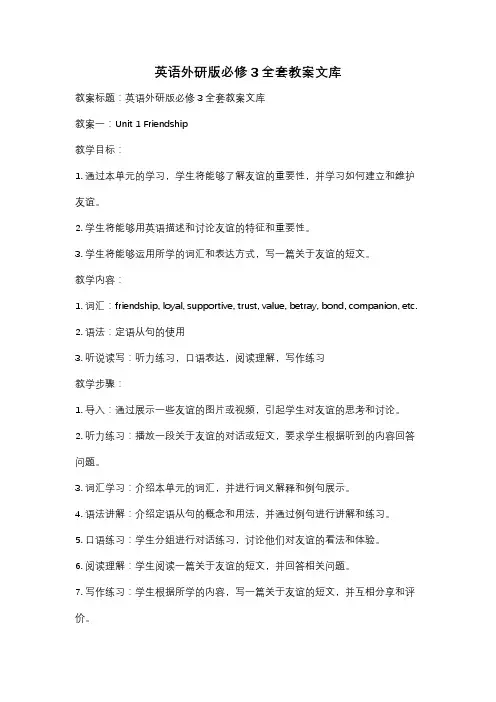
英语外研版必修3全套教案文库教案标题:英语外研版必修3全套教案文库教案一:Unit 1 Friendship教学目标:1. 通过本单元的学习,学生将能够了解友谊的重要性,并学习如何建立和维护友谊。
2. 学生将能够用英语描述和讨论友谊的特征和重要性。
3. 学生将能够运用所学的词汇和表达方式,写一篇关于友谊的短文。
教学内容:1. 词汇:friendship, loyal, supportive, trust, value, betray, bond, companion, etc.2. 语法:定语从句的使用3. 听说读写:听力练习,口语表达,阅读理解,写作练习教学步骤:1. 导入:通过展示一些友谊的图片或视频,引起学生对友谊的思考和讨论。
2. 听力练习:播放一段关于友谊的对话或短文,要求学生根据听到的内容回答问题。
3. 词汇学习:介绍本单元的词汇,并进行词义解释和例句展示。
4. 语法讲解:介绍定语从句的概念和用法,并通过例句进行讲解和练习。
5. 口语练习:学生分组进行对话练习,讨论他们对友谊的看法和体验。
6. 阅读理解:学生阅读一篇关于友谊的短文,并回答相关问题。
7. 写作练习:学生根据所学的内容,写一篇关于友谊的短文,并互相分享和评价。
教学评估:1. 口语表达评估:观察学生在口语练习中的表达能力和语法运用情况。
2. 阅读理解评估:检查学生对于友谊相关文章的理解能力和问题回答的准确性。
3. 写作评估:评估学生写作能力和对友谊的理解和表达。
教案二:Unit 2 Healthy eating教学目标:1. 通过本单元的学习,学生将能够了解健康饮食的重要性,并学习如何选择和准备健康食物。
2. 学生将能够用英语描述和讨论健康饮食的原则和方法。
3. 学生将能够运用所学的词汇和表达方式,写一篇关于健康饮食的短文。
教学内容:1. 词汇:healthy eating, balanced diet, nutrients, vitamins, minerals, carbohydrates, protein, etc.2. 语法:情态动词的使用3. 听说读写:听力练习,口语表达,阅读理解,写作练习教学步骤:1. 导入:通过展示一些健康食物的图片或视频,引起学生对健康饮食的思考和讨论。
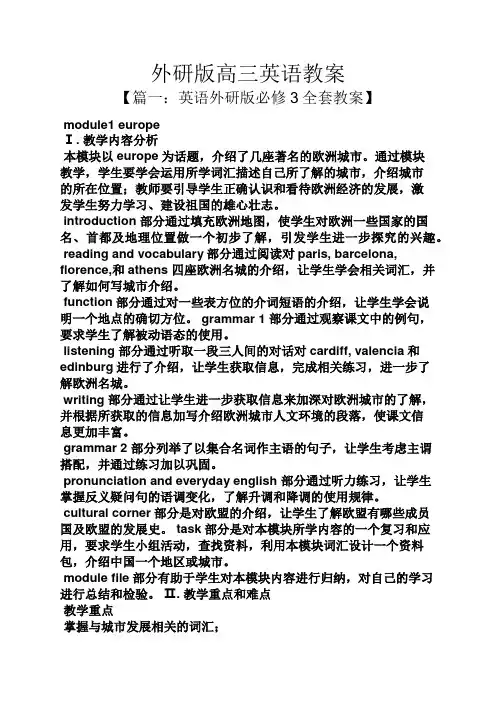
外研版高三英语教案【篇一:英语外研版必修3全套教案】module1 europeⅠ. 教学内容分析本模块以europe为话题,介绍了几座著名的欧洲城市。
通过模块教学,学生要学会运用所学词汇描述自己所了解的城市,介绍城市的所在位置;教师要引导学生正确认识和看待欧洲经济的发展,激发学生努力学习、建设祖国的雄心壮志。
introduction 部分通过填充欧洲地图,使学生对欧洲一些国家的国名、首都及地理位置做一个初步了解,引发学生进一步探究的兴趣。
reading and vocabulary部分通过阅读对paris, barcelona, florence,和athens 四座欧洲名城的介绍,让学生学会相关词汇,并了解如何写城市介绍。
function部分通过对一些表方位的介词短语的介绍,让学生学会说明一个地点的确切方位。
grammar 1 部分通过观察课文中的例句,要求学生了解被动语态的使用。
listening 部分通过听取一段三人间的对话对cardiff, valencia和edinburg进行了介绍,让学生获取信息,完成相关练习,进一步了解欧洲名城。
writing 部分通过让学生进一步获取信息来加深对欧洲城市的了解,并根据所获取的信息加写介绍欧洲城市人文环境的段落,使课文信息更加丰富。
grammar 2 部分列举了以集合名词作主语的句子,让学生考虑主谓搭配,并通过练习加以巩固。
pronunciation and everyday english 部分通过听力练习,让学生掌握反义疑问句的语调变化,了解升调和降调的使用规律。
cultural corner部分是对欧盟的介绍,让学生了解欧盟有哪些成员国及欧盟的发展史。
task部分是对本模块所学内容的一个复习和应用,要求学生小组活动,查找资料,利用本模块词汇设计一个资料包,介绍中国一个地区或城市。
module file部分有助于学生对本模块内容进行归纳,对自己的学习进行总结和检验。
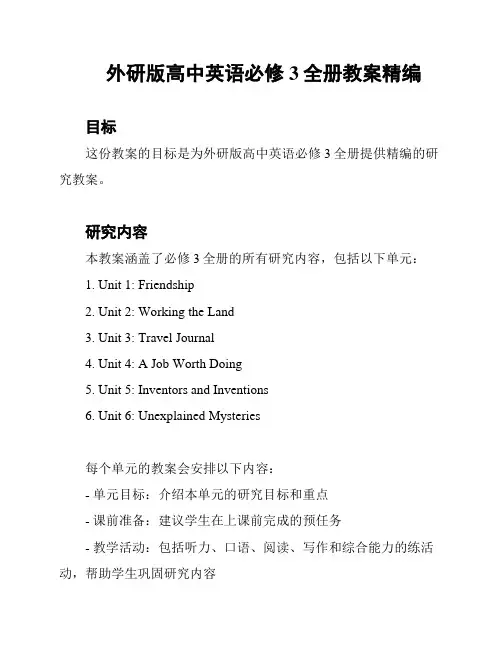
外研版高中英语必修3全册教案精编目标这份教案的目标是为外研版高中英语必修3全册提供精编的研究教案。
研究内容本教案涵盖了必修3全册的所有研究内容,包括以下单元:1. Unit 1: Friendship2. Unit 2: Working the Land3. Unit 3: Travel Journal4. Unit 4: A Job Worth Doing5. Unit 5: Inventors and Inventions6. Unit 6: Unexplained Mysteries每个单元的教案会安排以下内容:- 单元目标:介绍本单元的研究目标和重点- 课前准备:建议学生在上课前完成的预任务- 教学活动:包括听力、口语、阅读、写作和综合能力的练活动,帮助学生巩固研究内容- 作业布置:提供合适的作业练,巩固学生的研究成果- 教学反思:教师可以根据学生的表现和反馈,对本节课进行总结和评估教学方法这份教案采用多种教学方法,使学生在听、说、读、写等方面都得到综合训练。
教案中会穿插使用一些互动活动、小组讨论和角色扮演等形式,激发学生的兴趣,提高课堂参与度。
教学时长每个单元的研究内容安排为4至6课时,具体根据实际教学情况灵活调整。
教学评估为了评估学生的研究成果,教案中会提供一些评估活动和测验题目,同时还会鼓励教师在每个单元结束时对学生的研究情况进行总结和评估。
其他建议教师可以根据学生的实际情况和教学资源的可用性,对教案中的教学活动进行适度调整和个性化拓展。
同时,教师还可以积极利用课余时间为学生提供更多相关的研究资源和参考资料,促进他们的自主研究和全面发展。
以上是《外研版高中英语必修3全册教案精编》的简要介绍,希望这份教案能够帮助教师有效地开展教学工作,提升学生的英语水平和学习能力。
外研版英语必修三教案外研版英语必修三教案1Teaching points: Grasp the important words and phrases.一、Warming up: 1. Greeting:T: Hello, boys and girls. Let us recite the seasons. Ok? Ss: Ok.T and Ss: spring, summer, autumn and winter.T: What day is it today?Ss: Today is ……2. Saying a chant:Hello, Meg, hello, Ted.What’s his name? He is Ben.What’s her name? She is Pat.How old is she? She is eight.How old is he? He is nine.3. Singing “Head, shoulders, knees and toes.二、New concept.T: Oh, you are great .Today let us learnModule 6ActivitiesUnit 1 What do you do at the weekend? (Writing and reading) 1. T: Do you like playing football?Ss: Yes, I do.T: What do you do at the weekend? (explain in Chinese ) Ss: I play basketball.T: I like reading at the weekend .What about you?Ss: I like swimming.T: You are great.T: And what do you have at school?You can say: I have ……Ss: I have English and Chinese.T: Do you like maths?Ss: Yes, I do. / (No, I don’t.)T: What do you do at 5 o’clock in the morning?I sleep in the morning. What about you?Ss: I sleep too.2. Do exercises: On the board write the following list1) What do you do at the weekend?I………..2) What do you have at school?I have …… and ……3. Listen and say. Play the tape, pause it after each utterance and let theSs repeat the sentences.4. Show the Ss some books .For example “Maths”“Chinese”“Science”Show the Ss some pictures “football”“sleep”“swimming5. Text 1) Listen and look.2) Answer questions:What do you do at ……o’clock in the morning?What do you have at school?三、Homework: 1) Read the text frequently and recite the text.2) Copy the following sentences 2 times.What do you do at the weekend?What do you have at school?外研版英语必修三教案2教学重点:words and phrases: half, past, have breakfast / dinner教学难点: What’s the time,please?It’s half past six.I have breakfast at half past six.热身复习:老师出示6个动词词组,同学读,并讲出每个词组的意思。
高中英语外研版教案教学目标1. 掌握本单元的核心词汇和短语。
2. 理解并能运用本单元的重点语法结构。
3. 提高听说读写四项基本技能,尤其是阅读理解和口语表达能力。
4. 培养学生的跨文化交际意识,了解英语国家的文化背景。
教学内容与分析本单元围绕“环境保护”这一主题展开,通过一系列的阅读材料、听力练习和口语活动,使学生对环境问题有更深入的了解,并能够用英语表达自己的观点和建议。
教学步骤第一步:导入新课- 通过展示一些环境污染的图片,引发学生对环境问题的关注。
- 讨论学生在日常生活中可以采取哪些环保措施。
第二步:词汇与短语学习- 列出本单元的核心词汇和短语,如ollution, conservation, recycle等,并通过例句加深理解。
- 小组活动,让学生用这些词汇和短语造句。
第三步:语法焦点- 讲解并练习使用虚拟语气表达假设情况,例如“If everyone recycled, we would have a cleaner environment.”- 完成相关语法练习题,巩固知识点。
第四步:听力训练- 播放一段关于环境保护的英语听力材料。
- 完成听力理解题目,检验学生的听力水平。
第五步:阅读理解- 阅读一篇关于环境保护的英文文章。
- 提出几个问题,让学生回答,检测他们的理解能力。
第六步:口语实践- 分组讨论,每组提出一个环保建议,并用英语进行简短的演讲。
- 其他同学提问或给出反馈,提高互动性。
第七步:写作练习- 要求学生写一篇短文,阐述自己对环境问题的看法和建议。
- 教师批改后,选取几篇优秀的作文在班上分享。
第八步:课堂小结- 总结本节课学到的重点内容。
- 布置相关的家庭作业,如背诵单词、复习语法点等。
教学反思。
外研版高中英语教学设计英文版一、教学任务及对象1、教学任务本教学设计以外研版高中英语教材为基础,针对高中学生进行英语教学。
教学任务旨在提高学生的英语综合运用能力,包括听、说、读、写四个方面,强调语言在实际生活中的运用。
教学内容涉及日常交流、文化认知、学术探讨等多个方面,以丰富多样的形式呈现,激发学生的学习兴趣。
2、教学对象本教学设计针对的教学对象为我国高中学生,他们已经具备一定的英语基础,能够进行简单的日常交流,但英语水平参差不齐。
在教学过程中,教师需关注学生的个体差异,因材施教,激发学生的学习兴趣,帮助他们建立自信,提高英语综合运用能力。
在教学过程中,教师需要充分考虑到学生的年龄特点、心理需求和学习动机,采用生动活泼、富有创意的教学方法,引导学生主动参与课堂,培养他们的自主学习能力和合作精神。
同时,注重培养学生的跨文化交际意识,使他们能够在日益国际化的社会中更好地运用英语,为未来的学习和发展打下坚实基础。
二、教学目标1、知识与技能(1)掌握并熟练运用英语语法、词汇、句型等基本知识,提高学生的英语语言表达能力。
(2)提高学生的英语听力水平,能理解并抓住日常交流、新闻报道、学术讲座等不同场景的主要信息。
(3)培养学生的英语阅读技巧,提高阅读速度和理解能力,能够分析、概括和评价文本内容。
(4)锻炼学生的英语写作能力,能撰写不同类型的文章,如记叙文、议论文、说明文等,并具备一定的文学素养。
(5)增强学生的英语口语表达能力,能够自信地参与课堂讨论、演讲、辩论等活动。
2、过程与方法(1)采用任务型教学法,让学生在完成具体任务的过程中,运用所学知识,提高语言实际运用能力。
(2)运用合作学习策略,鼓励学生之间相互交流、讨论、分享,培养团队协作能力和沟通能力。
(3)利用现代教育技术手段,如网络资源、多媒体等,丰富教学手段,提高教学效果。
(4)实施差异化教学,关注学生的个体差异,为学生提供适合其发展的学习资源和方法。
外研社高中英语教案一、前言1. 教学目标:通过本章的学习,使学生能够熟练运用英语进行日常交流,提高听、说、读、写四项基本技能。
2. 教学内容:本章主要介绍了日常生活中常见的场景,包括问候、介绍、道别等,以及相关词汇和句型。
3. 教学方法:采用任务型教学法,通过角色扮演、小组讨论等形式,激发学生的学习兴趣,提高学生的实际运用能力。
二、Lesson 1:Greetings and Introductions1. 教学目标:学生能够用英语进行问候和自我介绍,掌握相关词汇和句型。
2. 教学内容:学习各种问候语,如“Hello!/Hi!/Good morning!/Good afternoon!/Good evening!”等,以及介绍自己和他人的句型,如“My name is”,“I e from”,“I am a”等。
3. 教学活动:(1)观看视频,学习问候语和自我介绍;(2)分组进行角色扮演,模拟真实场景进行问候和自我介绍;(3)小组讨论,分享彼此的问候习惯和自我介绍方式。
三、Lesson 2:Asking and Giving Directions1. 教学目标:学生能够用英语询问和指路,掌握相关词汇和句型。
2. 教学内容:学习询问地点的句型,如“Excuse me, where is the?”,“Could you please tell me how to get to?”等,以及指路的句型,如“Go strght ahead”,“Turn left/right”等。
3. 教学活动:(1)观看视频,学习询问和指路的句型;(2)分组进行角色扮演,模拟真实场景进行询问和指路;(3)小组讨论,分享彼此在日常生活中的询问和指路经验。
四、Lesson 3:Ordering Food1. 教学目标:学生能够用英语点餐,掌握相关词汇和句型。
2. 教学内容:学习点餐的句型,如“I'd like”,“Could I have?”等,以及询问菜单和菜品的句型,如“What do you remend?”,“I don't like”等。
外研社高中英语教案第一章:教学目标与方法1.1 教学目标了解本节课的主要内容和目标。
提高学生的英语听、说、读、写能力。
培养学生的团队合作和沟通能力。
1.2 教学方法使用互动式教学方法,鼓励学生积极参与。
使用任务型教学方法,让学生通过完成任务来提高英语能力。
使用小组合作学习,培养学生的团队合作能力。
第二章:教学内容与步骤2.1 教学内容引入本节课的主题和关键词汇。
通过阅读和听力材料,让学生理解和掌握相关的语言知识。
通过口语练习和写作任务,提高学生的表达和应用能力。
2.2 教学步骤引入主题:通过问题或情境引起学生的兴趣和思考。
展示材料:展示相关的阅读和听力材料,让学生进行理解和分析。
口语练习:通过小组讨论或角色扮演等活动,让学生进行口语练习。
写作任务:布置相关的写作任务,让学生进行思考和表达。
第三章:课堂活动与评估3.1 课堂活动设计相关的课堂活动,让学生积极参与和展示自己的能力。
通过小组讨论、角色扮演、口头报告等形式,让学生进行互动和合作。
提供适当的反馈和指导,帮助学生改进和提高。
3.2 评估方式通过观察学生的表现和作业完成情况进行评估。
采用自我评估和同伴评估的方式,让学生进行自我反思和相互评价。
根据学生的表现和进步,给予适当的鼓励和表扬。
第四章:教学资源与材料4.1 教学资源使用多媒体教学资源,如PPT、视频、音频等,增加课堂的趣味性和互动性。
使用教材和相关教辅材料,提供丰富的学习资源。
利用网络资源,获取更多的信息和资料。
4.2 教学材料准备相关的阅读和听力材料,如文章、故事、对话等。
设计口语练习和写作任务,提供学生表达和应用的机会。
提供反馈和指导,帮助学生改进和提高。
第五章:教学总结与反思5.1 教学总结对本节课的教学进行总结,回顾教学目标和内容的完成情况。
分析学生的表现和进步,总结教学方法和活动的效果。
5.2 教学反思反思教学过程中的优点和不足,提出改进的建议和措施。
考虑学生的需求和反馈,调整教学计划和方法。
外研社高中英语教案教案标题:《外研社高中英语教案》教案概述:本教案旨在为高中英语教师提供一份专业的教案建议和指导,以帮助教师有效地教授外研社出版的高中英语教材。
教案涵盖了高中英语各个教育阶段的要求,旨在提供全面的教学支持,促进学生的语言能力和综合素养的提升。
教案结构:1. 教学目标:明确每节课的教学目标,确保学生能够达到预期的学习成果。
2. 教学重点与难点:确定每节课的重点和难点,以便教师能够有针对性地进行教学。
3. 教学准备:列出教师在备课过程中需要准备的教学资源和教具。
4. 教学过程:详细描述每节课的教学步骤和教学方法,包括引入新知识、讲解重点内容、进行练习和巩固、展开拓展等。
5. 教学评价:提供教学评价的方法和标准,以便教师能够对学生的学习情况进行评估和反馈。
6. 教学延伸:提供一些教学延伸活动和资源,以便教师能够进一步拓展学生的学习内容和能力。
教案建议和指导:1. 确保教学目标与教材要求相符:教师在撰写教案时,应仔细研读外研社高中英语教材,并确保教学目标与教材要求相一致。
教师可以根据学生的实际情况和学习需求进行适当的调整。
2. 注重任务型教学:外研社高中英语教材注重培养学生的语言运用能力,因此在教学过程中,教师应注重任务型教学,引导学生通过实际任务的完成来提高语言运用能力。
3. 多样化的教学方法:教师可以灵活运用多种教学方法,如小组合作学习、角色扮演、讨论等,以激发学生的学习兴趣和积极性。
4. 引导学生自主学习:教师应鼓励学生主动参与课堂活动,培养学生的自主学习能力。
教师可以设计一些开放性问题,引导学生进行思考和探索。
5. 及时反馈和评价:教师应及时对学生的学习情况进行反馈和评价,帮助学生及时发现问题并加以改进。
通过以上的教案建议和指导,教师可以更好地利用外研社高中英语教材进行教学,提高学生的学习效果和综合素养。
同时,教师也可以根据自己的实际情况和学生的需求进行适当的调整和创新,以提升教学质量和学生的学习体验。
外研版高三英语教案篇一:英语外研版必修3全套教案Module1 EuropeⅠ. 教学内容分析本模块以Europe为话题,介绍了几座著名的欧洲城市。
通过模块教学,学生要学会运用所学词汇描述自己所了解的城市,介绍城市的所在位置;教师要引导学生正确认识和看待欧洲经济的发展,激发学生努力学习、建设祖国的雄心壮志。
Introduction 部分通过填充欧洲地图,使学生对欧洲一些国家的国名、首都及地理位置做一个初步了解,引发学生进一步探究的兴趣。
Reading and vocabulary部分通过阅读对Paris, Barcelona, Florence,和Athens 四座欧洲名城的介绍,让学生学会相关词汇,并了解如何写城市介绍。
Function部分通过对一些表方位的介词短语的介绍,让学生学会说明一个地点的确切方位。
Grammar 1 部分通过观察课文中的例句,要求学生了解被动语态的使用。
Listening 部分通过听取一段三人间的对话对Cardiff, Valencia和Edinburg进行了介绍,让学生获取信息,完成相关练习,进一步了解欧洲名城。
Writing 部分通过让学生进一步获取信息来加深对欧洲城市的了解,并根据所获取的信息加写介绍欧洲城市人文环境的段落,使课文信息更加丰富。
Grammar 2 部分列举了以集合名词作主语的句子,让学生考虑主谓搭配,并通过练习加以巩固。
Pronunciation and Everyday English 部分通过听力练习,让学生掌握反义疑问句的语调变化,了解升调和降调的使用规律。
Cultural Corner部分是对欧盟的介绍,让学生了解欧盟有哪些成员国及欧盟的发展史。
Task部分是对本模块所学内容的一个复习和应用,要求学生小组活动,查找资料,利用本模块词汇设计一个资料包,介绍中国一个地区或城市。
Module File部分有助于学生对本模块内容进行归纳,对自己的学习进行总结和检验。
Ⅱ. 教学重点和难点教学重点掌握与城市发展相关的词汇;学习主谓一致及被动语态的语法功能;学习运用不同的介词表达不同的位置。
教学难点听懂与城市介绍相关的表达,正确理解并使用新词汇;注意主谓一致的表达;学会从地理位置、历史、人文等多个角度来介绍一座城市或地区。
Period1 Introduction Function课题:Module1 EuropePeriod1 Introduction Function学情分析There are 2 parts in this period. From the introduction part, the students will be able to know some European countries and their capitals, while the Function part focus on describing location. To motivate the Ss’enthusiasm in taking partin the classroom activities, I can organize a group competition to decide which group will do the best in completing the tasks.课程目标知识与能力Help Ss get familiar with the name of some European countries and the main cities.Get Ss to describe the location of a country or a city in the similar way.过程与方法Train Ss speaking ability via the individual performances.Write similar sentences.Help Ss get prepared for reading.情感态度与价值观They can know more about European countries from the Introduction and also know how to describe their favourite places in an acceptable way via Function part.重点Improving the students’oral ability. Description a place.难点How to help Ss improve their speaking ability.How to help Ss make to describe a place.Lead Ss to talk in class actively.教法Task-based Approach 学法Cooperation 手段A tape recorder, A blackboard 教学过程Step 1. Lead-in: IntroductionIntroduce more about some European countries.Europe 欧洲Learn the new words and expressions.Step 2. Reading and MatchcountrycapitallanguageUnited kingdomLondonEnglishGreeceAthensGreekFranceParisFrenchItalyRomeItalianSpainMadridSpanishPortugalLisbonPortugueseGet the Ss to read the words in the table.Get the Ss to fill in the blanks.Get the Ss to do the Match with the map in pair.Step 3 FunctionRead the sentences and write similar sentences about Tianjin Italy is in the south of Europe.Portugal is to the west of Spain.Barcelona is on the northeast coast of Spain.The UK is off the northwest of Europe.Now do you know how to describe location?Paris is situated ____the River Seine.There is a mountain _______France and Italy.Barcelona is a city ____the coast of Spain.Britain is an island ____the coast of Europe.France and England face each other ____ the EnglishChannel.Mongolia is ________China and Russia.China is ________________of India.Guangzhou is ___________of China.Shenyang is _________Beijing and Harbin.Chongqing is situated ___the Yangtze River.The Qinghai-Tibet Plateau is______________of China.Step 4 SummaryIn this class the Ss mainly have learned some new words about European countriesand also know how to describe a place in an acceptable way.板书Module1EuropePeriods 1locate/location/located be located on/in/toTian jin is situated on Haihe River,Tianjin is located in the north of China.Tianjin is on the north coast of China.Shanghai is on the east coast of China.Taiwan is off the east coast of China.反馈Workbook P68, Exs 6, 7 and P 69 Ex4 .作业Memorize the new words of this period. Preview the reading passage.反思It is necessary and important to arouse the students’interests and get all Ss involved in various interesting activities Period2 Reading and V ocabulary课题:Module 1 EuropePeriod 2 Reading and V ocabulary学情分析This period is intended to improve the Ss’reading ability via the reading passage. The Ss will be able to know more about the European countries like the location, history and custom. To arouse their interests, group works are very useful.课程目标知识与能力Make Ss learn to sum up grammatical rules themselves. Make sure Ss can apply the grammar correctly.Train Ss’speaking ability.过程与方法Make Ss master some words, phrases and sentence patterns.Encourage Ss to participate in class actively.Help Ss to improve their reading ability.情感态度与价值观Train Ss speaking ability through individual and pair work. Explanations to help Ss to make sense of the passage better.Discussion to help Ss prepare for reading.重点Encourage the Ss to sum up grammatical rules.Help the Ss to improve their speaking ability.难点This section provides anopportunity for Ss to learn some vocabulary about countries. Meanwhile, they can know more about European countries.教法Task-based Approach学法Cooperation 手段A tape recorder, A blackboard 教学过程Step 1. Lead-in , Introduction and V ocabularyIntroduce more about some European countries.Learn the new words and expressions.Step 2. ReadingRead the passage and match the photos with these descriptions.Ask the Ss to do the activity individually, then check with a partner. Call back the answers from the whole class, asking for whole sentences.1).Which of the cities are capital cities?2).Which one is situated on the coast?3).Which is famous for its places to eat?4).Which ones are or were important cities for writers and artists?5).Which was the world’s greatest city a long time ago?4.Read the passage again and decide if these sentences are true or false1).The Eiffel Tower is a tall building in France.2). There are a lot of restaurants and cafes in Paris.3).Barcelona is the capital of Spain.4).The Church of the Sagrada Familia was built in 1926.5).The artistic movement called the Renaissance began in Florence.6). The Uffizi Palace is a famous hotel in Florence.7).A long time ago, Athens was the world’s most powerful city.8). There were a lot of good writers in ancient Athens.Step 3 Language Pointslo1. on the coast of, off the coast of,coast means the area where the land meets the oceanon the coast means on the land near the oceanoff the coast means in the ocean near the land2. faceMy house faces the sea.She turned to face me.He is facing the biggest challenge of his career.If found guilty, he could face up to 20 years in jail.I want to have a face- to -face talk with you.His father hit him in the face.3. acrossShe took a ship across the Atlantic.The boat carried them across the river.The police pushed their way through the crowd.across为穿过一个平面,而through为穿过一个立体空间4. be situated/located 加介词表示某物的位置。